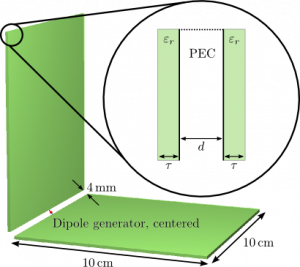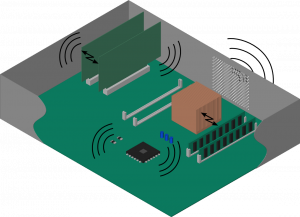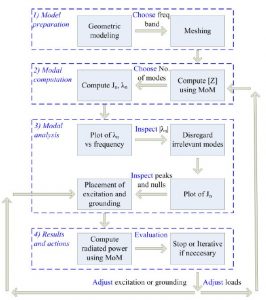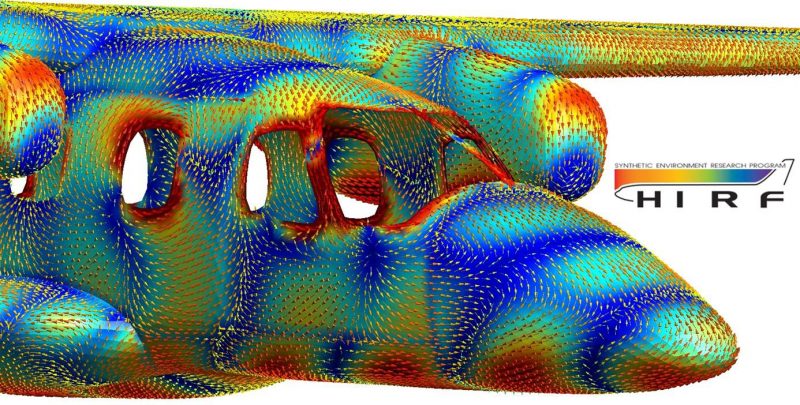Thermo-Electrical EMC Filter Design for Electric Vehicles (TEFDEV)

In the powertrain of electric cars, high demands are placed on the inverters that generate the three-phase AC voltage for the electric motor from the battery’s DC voltage. They must be small, light, inexpensive and efficient. Additionally, the trend in the electric car industry is towards higher power, voltage and switching frequency. This results in high electrical and thermal loads on all components within the powertrain as well as higher radiated and conducted emissions. Passive filters are used to ensure that the electromagnetic emissions are below the target limit values. During operation, losses in the filter components can lead to their maximum temperature being exceeded (<120°C). The project includes the design and optimization of these filters. Innovative, combined thermal-electrical processes are to be used to solve the current problem of thermal overload of EMC filters and prevent possible vehicle failures. During the course of the project, a digital representation of the system (Digital Twin) will be developed to investigate and predict the system behavior using data-based methods.
This project is conducted in cooperation with Valeo eAutomotive Germany GmbH and its EMC department in the Powertrain Systems division. The project is supported by Guido Rasek at Valeo.
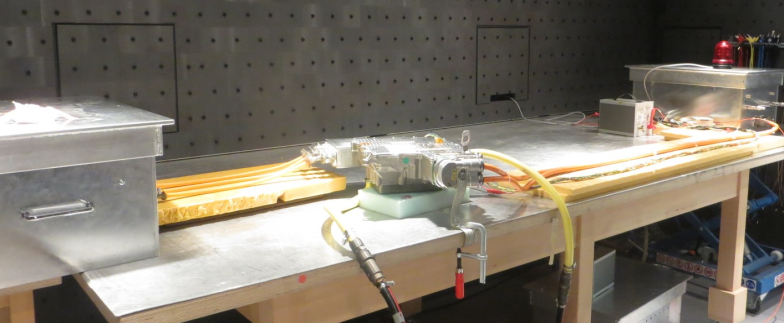
Measurement setup for EMC investigation of an electric power train. (Source: Valeo)

Heating of the filter caused by the dynamic disturbances in the drive train in different topologies. While the insertion of an inductor can lead to a reduction in the temperature at the first capacitor of the filter, this potentially leads to overheating of the inductor. (Source: Valeo)
Funding: Valeo eAutomotive Germany GmbH
Contact: Lennart Bohl, M. Sc.
Start date: 01.10.2023
Active Learning for Optimization of EMC processes
With the ever increasing operating frequencies and powers, EMC has now become a major consideration on any project involving the design, construction, manufacture and installation of electrical and electronic equipment and systems. An important step in the design of components and prediction of EMC related problems is the modeling and simulation. The complexity and performance of electrical and electronic devices as well as the number and range of variables in the design spaces means that many of the Physics-Based (PB) used tools are either too slow or too inaccurate for effective design and optimization. Recently, machine learning (ML) tools and techniques have been increasingly used in the EMC domain either to improve PB approaches or to replace them. In ML, computers are used to probe vast amounts of data for structure. One requirement for the effective ML model building is the availability of these large datasets for the training and testing processes. The generation of simulation data of EMC systems using PB tools is more than often quite expensive and very time consuming.
The main goal of this project is the adaptation and extension of active learning schemes such as Bayesian Optimization (BO) to the realm of EMC. In active learning, the expensive to evaluate samples used for training and prediction are intelligently collected at each iteration to reduce the needed number of simulation runs. The active learning methods can be used for optimization tasks, modeling of systems or both at the same time. The main working points can be summarized as:
- Adaptation and foundation-laying of BO-based optimization and model building in the fields of EMC, SI, PI and bio-EMC.
- Establishment of a framework to evaluate the certainty in the solutions provided by the active learning scheme.
- Contribution to the available databases with the generated datasets for the service of the electrical engineering and EMC community.
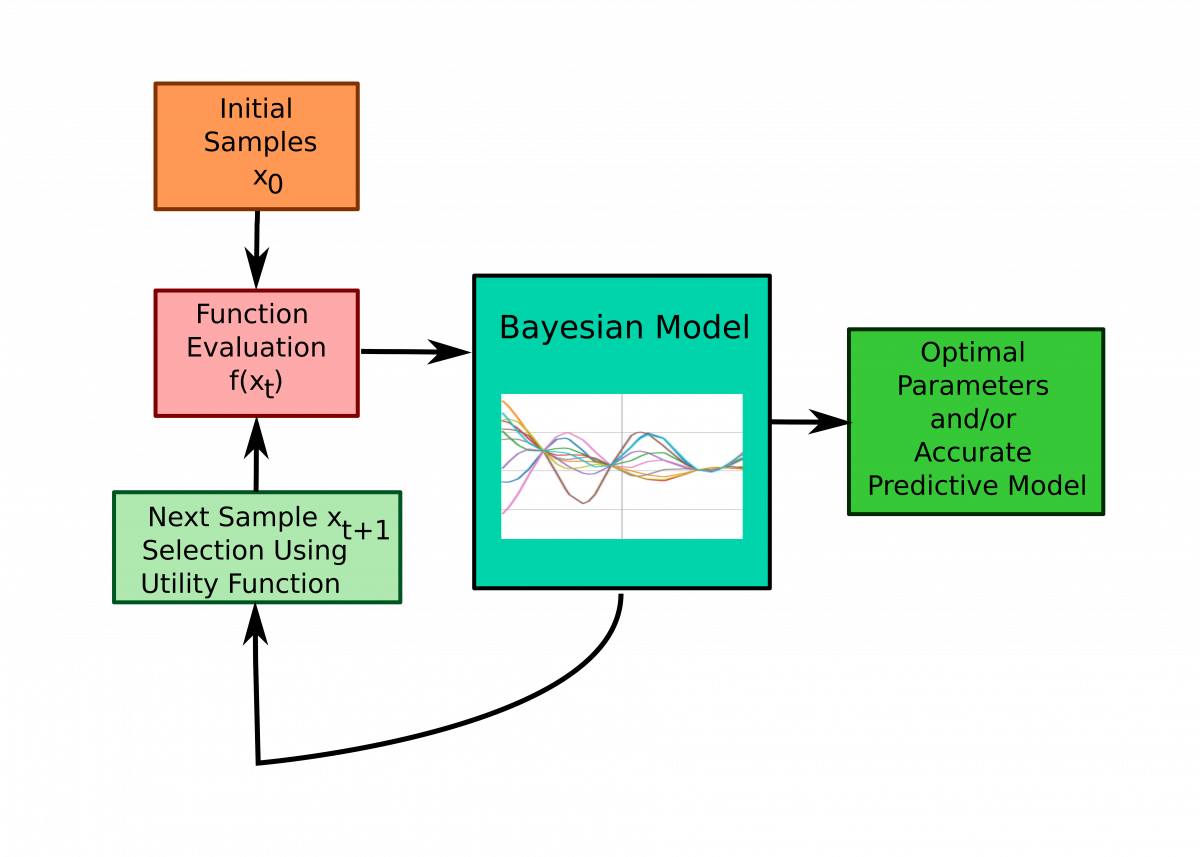
Bayesian active learning and optimization scheme used to intelligently select the next samples to be simulated and added to the available data. The data is fed to the Bayesian model that predicts the optimal parameters while actively building an accurate model. Source: TET, TUHH
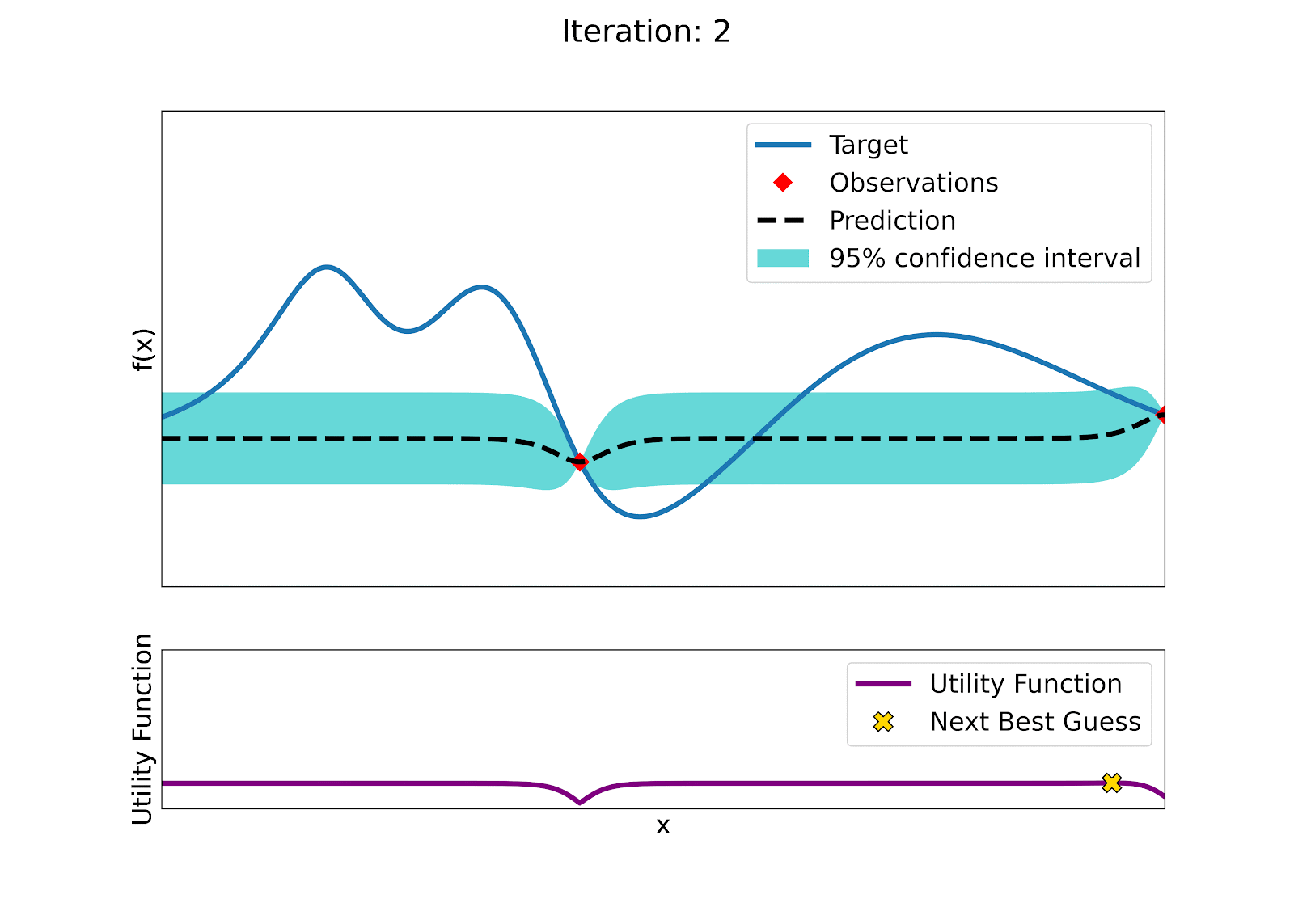
Animation of Bayesian active learning to approximate and maximize a 1D function f(x). The utility function is used at each iteration to pick the next best sample x to observe. The observations are used to create a more accurate approximation of the function and find the maxima. Source: TET, TUHH
Funding: Scholar of the Konrad Adenauer Foundation
Contact: Youcef Hassab
Start date: 02.11.2022
Analysis of Orbital Angular Momentum (OAM) antennas in Complex Environments
Michael Wullf, M. Sc. (DFG-Project), 01.12.2019 – 30.11.2023
Electromagnetic waves can have a form of moment called the Orbital Angular Momentum (OAM). In waves with this property, the area perpendicular to the direction of propagation does not have a constant phase, as is the case with plane waves. Rather, the phase varies around the center of the wave and this phase distribution rotates in the direction of propagation. From the possible phase distributions and the direction of rotation different orthogonal modes result. This means that the modes do not influence each other and can therefore be used well for communication purposes.
In the past some properties of communication with OAM antennas have been investigated. The properties of OAM antennas shall now be further analyzed from the point of view of EMC.
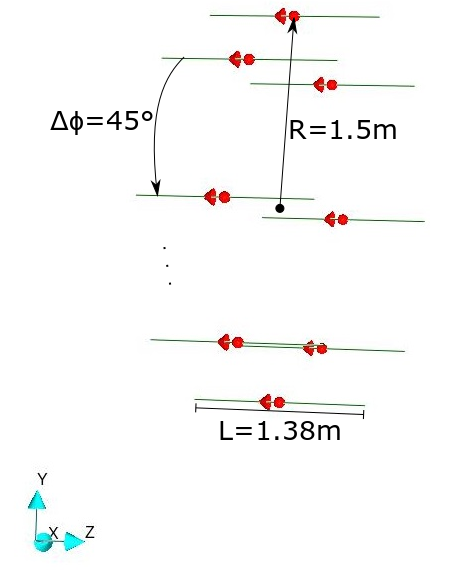
Dipolar array of eight elements with which the first OAM mode is excited by operating the individual dipoles with a phase difference of ∆Φ=45°. The operating frequency is f=100 MHz. Source: TET, TUHH
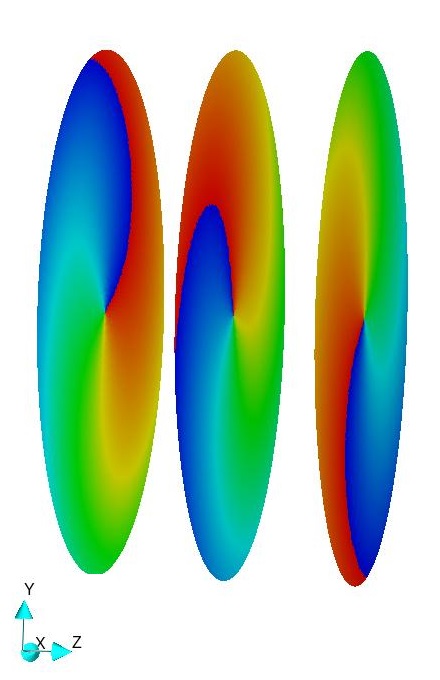
Phase of the z-component of the E-field on the surface perpendicular to the direction of propagation. The phase was evaluated in three different distances to the antenna. As antenna a dipole array of eight elements was used, which excites the first OAM mode. The circular sections show how the phase rotates exactly 360° in the azimuthal direction. You can also see how this phase distribution rotates in the direction of propagation. Source: TET, TUHH
Related Publications:
Inter Mode Interference in Circular Antenna Arrays for Orbital Angular Momentum (OAM) Based Communication Proceedings Article In: IEEE International Symposium on Antennas and Propagation and USNC-URSI Radio Science Meeting, Denver, USA, July 10-15, 2022. |
Shielding of Orbital Angular Momentum Waves by a Cavity With Apertures Journal Article In: IEEE Transactions on Electromagnetic Compatibility, vol. 64, no. 3, pp. 692-701 , 2022. |
Regularized and Compressed Large-Scale Rational Macromodeling: Theory and Application to Energy-Selective Shielding Enclosures Journal Article In: IEEE Transactions on Electromagnetic Compatibility, vol. 64, no. 5, pp. 1365-1379, 2022. |
Signal Integrity Assessment of External ESD Protection for Gbits/s Data Rates on Ceramic Test Fixture Proceedings Article In: IEEE Workshop on Signal and Power Integrity (SPI), Siegen, Germany, May 22 -25, 2022. 2022. |
Parametric S-Parameters for PCB based Power Delivery Network Design Using Machine Learning Proceedings Article In: IEEE Workshop on Signal and Power Integrity (SPI), Siegen, Germany, May 22 -25, 2022. |
Effect of the Orientation of the Array Elements of Uniform Circular Antenna Arrays on Orbital Angular Momentum (OAM) Modes Proceedings Article In: German Microwave Conference (GeMiC), Ulm, Germany, May 16 -18, 2022, ISSN: 2167-8022 . |
Evaluation of Interconnects up to 100 GHz Using Machine Learning PhD Thesis 2022, ISBN: 978-3-8440-8534-1. |
Iteration Dependent Waveform Relaxation for Hybrid Field Nonlinear Circuit Problems Journal Article In: IEEE Transactions on Electromagnetic Compatibility, vol. 64, no. 4, pp. 1124-1139, 2022. |
Improving Accuracy After Stability Enforcement in the Loewner Matrix Framework Journal Article In: IEEE Transaction on Microwave Theory and Techniques, vol. 70, no. 2, pp.1037-1047, 2022. |
Multiconductor Transmission Lines for Orbital Angular Momentum (OAM) Communication Links Journal Article In: IEEE Transactions on Components, Packaging and Manufacturing Technology, vol. 12, no. 2, pp. 329-340, 2022. |
Analysis and Optimization of Nonlinear Diode Grids for Shielding of Enclosures With Apertures," Journal Article In: IEEE Transactions on Electromagnetic Compatibility, vol. 63, no. 6, pp. 1884-1895, 2021. |
Distributed Nonlinear Shielding in Power Delivery Networks on Printed Circuit Boards Proceedings Article In: IEEE Conference on Electrical Performance of Electronic Packaging and Systems (EPEPS), virtual event, Austin, TX, USA, October 17-20, 2021. |
Evaluation of Support Vector Machines for PCB based Power Delivery Network Classification Proceedings Article In: IEEE Conference on Electrical Performance of Electronic Packaging and Systems (EPEPS), virtual event, Austin, TX, USA, October 17-20, 2021. |
Introducing Functional Via Structures to Low Temperature Cofired Ceramics: How to Optimize Reliably and Efficiently Journal Article In: IEEE Electromagnetic Compatibility Magazine, vol. 10, no. 4, pp. 35-45, 2021. |
ANN Hyperparameter Optimization by Genetic Algorithms for Via Interconnect Classification Proceedings Article In: IEEE Workshop on Signal and Power Integrity (SPI), virtual event, Siegen, Germany, May 10-12, 2021. |
Efficient and Flexible Huygens’ Source Replacement of mm-scale Human Brain Implants Proceedings Article In: Joint IEEE International Symposium on Electromagnetic Compatibility, Signal and Power Integrity (EMCS+SIPI) and Symposium on EMC Europe (EMC Europe), virtual event, Glasgow, Scotland, July 26 - August 20, 2021. |
Analysis of Differential Crosstalk and Transmission for Via Arrays in Low Temperature Cofired Ceramics Proceedings Article In: IEEE Workshop on Signal and Power Integrity (SPI), virtual event, Siegen, Germany, May 10-12, 2021. |
Numerical Analysis of Two MIMO Channels Carrying Orbital Angular Momentum (OAM) Proceedings Article In: European Conference on Antennas and Propagation (EuCAP), virtual event, Düsseldorf, Germany, March 22-26, 2021. |
Vertical Integration of Passive Microwave Components Using Functional Via Structures in LTCC Multilayer Substrates Journal Article In: IEEE Transactions of Components, Packaging and Manufacturing Technology, vol. 11, no. 4, pp. 635-646, 2021. |
Macromodeling of Mutual Inductance for Displaced Coils Based on Laplace’s Equation Journal Article In: IEEE Transactions on Instrumantation and Measurement, vol. 70, 2021. |
A Multistage Adaptive Sampling Scheme for Passivity Characterization of Large-Scale Macromodels Journal Article In: IEEE Transactions on Components, Packaging and Manufacturing Technology, vol. 11, no. 3, pp. 471-484, 2021. |
SI/PI-Database of PCB-Based Interconnects for Machine Learning Applications Journal Article In: IEEE Access, vol. 9, pp. 34423-34432, 2021. |
Vertically Integrated Microwave-Filters Using Functional Via Structures in LTCC Proceedings Article In: European Microwave Conference (EuMC), virtual event, Utrecht, Netherlands, Jan. 12-14, 2021. |
ANN Performance for the Prediction of High-Speed Digital Interconnects over Multiple PCBs Proceedings Article In: IEEE Conference on Electrical Performance of Electronic Packaging and Systems (EPEPS) San Jose, CA, USA, 2020. |
Wireless Communication of Radio Waves Carrying Orbital Angular Momentum (OAM) Above an Infinite Ground Plane Journal Article In: IEEE Transactions on Electromagnetic Compatibility, vol. 62, no. 5, pp. 2257-2264, 2020. |
EMC of Complex Systems
Ph. D. Thesis Fabian Happ. 01.04.2012 – 01.09.2017
In this thesis a numerical method based on the Method of Moments and analytical formulations are developed to calculate electromagnetic fields in the vicinity of Carbon Fiber Composite (CFC) materials. The methods are applied to predict the shielding effectiveness of different CFC materials, to calculate lightning transfer functions for the coupling into an aircraft geometry made of CFC, and to estimate the influence of CFC on the crosstalk between transmission lines.
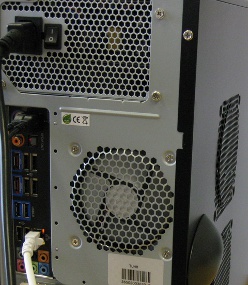
Apertures in a Computer casing (Source: TET, TUHH).
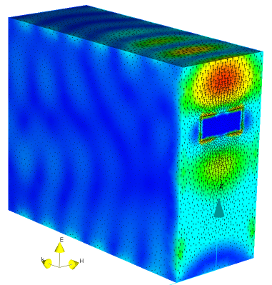
Current distribution on a field illuminated Computer casing (Source: TET, TUHH).
Related Publications:
HIRF Protection Using Energy Selective Diode Arrays
Cheng Yang, M. Sc., (China Scholarship Council (CSC)), 01.04.2015 – 17.10.2016
With more and more electromagnetic energy being transmitted by radar, radio, TV, mobile, hotspot (Wi-Fi), satellite, and other transmitters, detrimental effects of electromagnetic waves on the environment, e.g. disturbance or even damage of electronic equipment, become more and more a concern. To ensure safe operation of various electronic systems in transmitting or receiving states, electromagnetic protection should be considered especially against high intensity radiation fields (HIRFs). This project focuses on diode arrays for implementation of self-activated and energy selective blocking of electromagnetic wave.
Based on the nonlinear behavior of diodes, diode arrays can be shown to be transparent with respect to small field amplitudes and opaque to large field amplitudes. In theory, we expect the structure to work like a spatial switch, while in practice its protection performance is limited by several factors, such as the response time and operating frequency range of the diodes, the transmission loss of the protective structure and near field coupling effects. Therefore, accurate full wave simulation are being used for evaluation of the electromagnetic performance of protective diode arrays. Up to now, mostly infinitely periodic diode arrays have been studied. Next steps include the simulation of finite and non-periodic diode arrays using the electromagnetic field simulator CONCEPT-II.
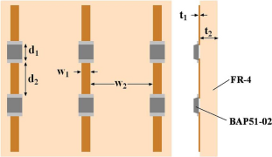
Geometrical model of diode array designed for vertical polarized protection against HIRF. The diode array consists of conductive strips and miniature diodes on a low dielectric loss substrate of thickness 0.8mm. The horizontal and vertical distance of adjacent diodes is 3.5 mm and 2.25, respectively (figure adapted from “A Novel Method of Energy Selective Surface for Adaptive HPM/EMP Protection,” IEEE APWL, vol. 12, pp. 112–115, 2013.)
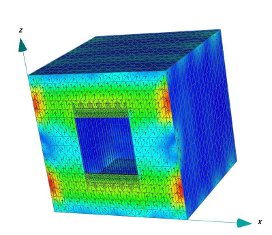
Evaluation model of diode array in CONCEPT-II. The array was placed in the front window of a PEC box, and a receiving antenna is positioned inside the PEC box (side length approx. 50 cm). What can be seen are the surface currents on the PEC box (red color indicates high current amplitudes).
Related Publications:
Analysis of Electromagnetic Interference in Server Casings
Ph.D. Thesis Alexander Vogt. 01.04.2011 – 08.04.2016
With increasing data rates EM emission has become a major issue for EMC and EMI considerations in current server designs. Major sources of EM emission inside include ICs, cables and connectors, and Printed Circuit Boards. While efficient techniques exist to model the interior coupling of PCB cavities (Zpp ), the external (3D) coupling still has to be computed using full-wave techniques.
This project aims to combine the different methods to model and simulate the components of the server. The dimensions and high data rates in addition to the high complexity of the individual components encountered in modern servers lead to a number of unknowns that are commonly in the range of several million. Therefore, efficient numerical methods and approximate models have to be developed.
Related Publications:
Application of the Characteristic Mode Analysis to Antenna Design and Electromagnetic Compatibility
Alexander-von-Humboldt Fellowship Prof. Qi Wu. 01.03.2014 – 29.02.2016
The Characteristic Mode Analysis (CMA) – based on the fundamental works of Harrington and Mautz – is a well-known numerical tool for antenna analysis and design. Within the numerical framework of the method of moments (MoM) the characteristic modes are found by the solution of a weighted matrix eigenvalue equation formulated with the MoM system matrix. The resulting current distributions are the eigencurrents and eigenvalues, respectively. The eigenvalues indicate if the corresponding eigencurrents may store primarily magnetic energy, or electric energy, or if they are “at resonance” and may radiate efficiently if excited. The eigencurrents constitute a set of (orthogonal) modes characteristic to the investigated structure (hence the name) and independent of any excitation. In antenna design inspection of the eigencurrents allows to identify e.g. suitable locations for generators and ways to improve radiation efficiency. In EMC analysis, the goals are opposite: analyze a potentially radiating structure and reduce its potential for emission.
During the Alexander von Humboldt Fellowship of Prof. Qi Wu at TUHH CMA was applied successfully to antenna design and extended to EMC analysis of digital systems. A full report of his fellowship is given in the following document PDF.
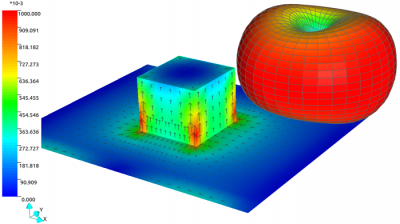
Eigencurrents in A/m and radiation eigenpatterns of a cubic heatsink on a motherboard at 500 MHz obtained by CONCEPT-II. Image taken from: “Characteristic Mode Analysis of Radiating Structures in Digital Systems,” IEEE Electromagnetic Compatibility Magazine.
Related Publications:
Accurate and Efficient Algorithms in the Method of Moments for the Analysis of High Intensity Radiated Field Coupling into Aircraft
Ph. D. Thesis Arne Schröder. 01.09.2009 – 31.08.2013
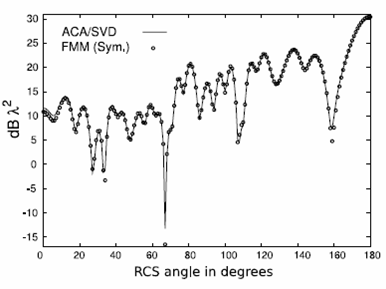
Bistatic radar cross section (RCS) of aircraft to the left. The comparison of two diffrent computation methods shows good agreement. (Source: TET, TUHH). (Source: TET, TUHH).
Related Publications:
Development of a Full-Wave Module for the High Intensity Radiated Field (HIRF) Synthetic Environment
EU-Project. 01.12.2008 – 13.05.2013
The “HIRF Synthetic Environment”, financed by the EU with a total of 45 partners, research project had the goal to provide a numerical modelling framework to the aeronautic industry which can be used during the development phase of aircraft for prediction of adequate electromagnetic immunity. For this purpose several state-of-the-art computational electromagnetic codes were integrated into a common modeling platform and validated against each other and against measurements. From the part of the Institute of Electromagnetic Theory the MoM code CONCEPT-II could be successfully adapated and integrated into the synthetic environment.
In the future, the availability of such a HIRF Synthetic Environment framework becomes more and more significant in order to be able to cope with competing requirements of new designs, with the related increase of testing, and the general demand of costs and time reductions.
Surface current distribution on aircraft due to HIRF illumination calculated by CONCEPT-II (Source: TET, TUHH).
Further Information: http://cordis.europa.eu/project/rcn/89387_en.html

